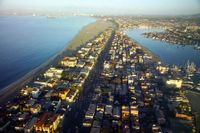On the evening of June 1, 2025, at approximately 11:34 p.m. Pacific time, a magnitude 2.4 earthquake rattled Long Beach, California, according to data from the U.S. Geological Survey (USGS). This minor seismic event was centered less than a mile from Los Angeles, with tremors also felt in nearby communities including Carson, Signal Hill, Rancho Palos Verdes, San Pedro, and Lomita.
The earthquake occurred at a depth of 7.6 miles beneath the earth’s surface, a relatively shallow depth that can sometimes result in noticeable shaking despite the low magnitude. Residents of Long Beach took to social media platform X to share their experiences. One user described the sensation as "Odd earthquake in Long Beach? Very brief. Sounded like a car hit the side of the house." Another confirmed feeling the tremors in Signal Hill, while others simply posted "Earthquake Long Beach," indicating widespread awareness of the event.
Although the magnitude 2.4 quake was minor, it highlights the persistent geological activity in the seismically active Los Angeles Basin. Long Beach and the greater Los Angeles area sit near significant fault lines such as the San Andreas Fault and the Newport-Inglewood Fault, which are known for producing larger and more destructive earthquakes.
According to recent three-year data from the USGS, the greater Los Angeles area experiences an average of 59 earthquakes annually with magnitudes ranging between 2.0 and 3.0. These smaller tremors often go unnoticed by residents but are closely monitored by geological authorities to better understand the region’s tectonic behavior. Notably, in the ten days leading up to this event, there had been no recorded earthquakes of magnitude 3.0 or greater in the vicinity, underscoring the relative quiet before this tremor.
Long Beach itself is a coastal city in southeastern Los Angeles County and ranks as the 44th-most populous city in the United States. Its location makes it particularly vulnerable to seismic events. The most significant earthquake in Long Beach’s recent history occurred on March 10, 1933, when a magnitude 6.4 quake struck around dinnertime. That devastating event caused widespread damage, resulted in 120 deaths, and inflicted over $50 million in property damage (a massive sum at the time).
While the 2025 quake was far less severe, it serves as a stark reminder of the region’s ongoing vulnerability to earthquakes. Local officials and emergency management agencies continue to urge residents throughout Southern California to maintain earthquake preparedness plans. This includes securing heavy furniture, having emergency supplies on hand, and knowing evacuation routes and safety protocols.
Real-time data and preparedness resources are readily accessible to the public through the USGS and local emergency services, which emphasize vigilance despite the low magnitude of many quakes. The 2.4 magnitude tremor in Long Beach is part of a broader pattern of seismic activity that reflects the dynamic and shifting earth beneath this bustling urban area.
Experts remind residents that even small earthquakes can serve as precursors or indicators of larger seismic events, making ongoing monitoring essential. The fact that this quake was felt by many, despite its modest size, highlights the importance of community awareness and readiness.
The Los Angeles Basin’s complex fault system means that seismic activity is a regular part of life for millions of residents. While the vast majority of these quakes cause little to no damage, they are a constant reminder of the powerful natural forces at play beneath the surface.
In summary, the magnitude 2.4 earthquake that struck Long Beach on June 1, 2025, was a minor but noteworthy event in a region known for its seismic activity. It was felt across several neighboring communities and serves as a reminder of the importance of preparedness in Southern California. With no larger quakes recorded in the preceding days, this event fits into the expected pattern of frequent small tremors in the area, but the memory of the devastating 1933 quake remains a sobering backdrop.
As Southern California continues to grow and develop, understanding and respecting the region’s geological risks remain paramount. Residents and officials alike must remain vigilant, ensuring that infrastructure, emergency plans, and public awareness keep pace with the ever-present threat of earthquakes.





